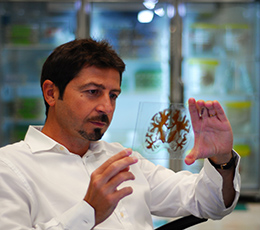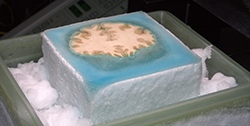|
UC San Diego’s ‘Brain Observatory’ to Examine
Brain of HM: World’s Most Famous Amnesiac
Procedure to be broadcast live on Internet
Debra Kain | December 07, 2009

Neuroanatomist Jacopo Annese, PhD
On Dec. 2, neuroanatomist Jacopo Annese will begin the process of slicing the brain of one of the most famous patients in the history of neuroscience. Portions of the work will broadcast live from The Brain Observatory lab, available for viewing at: http://thebrainobservatory.ucsd.edu/.
The brain of one of the most famous patients in the history of neuroscience is going back under the knife…and scientists and students around the world can have a front-row seat.
In 1953, the 27-year-old Henry Molaison, known throughout five decades of research only as the amnesic patient “HM,” agreed to undergo experimental brain surgery in hopes that it would relieve his frequent and severe epileptic seizures. After removal of most of his medial temporal lobes, the frequency of HM’s seizures lessened considerably, but at the cost of his ability to make new memories. This astonishing outcome initiated decades of scientific discoveries that have radically changed our understanding of memory function in the brain.
In 2008, HM died in a nursing home in Hartford, Conn., where he had lived in cognito for many years. Neuroanatomist Jacopo Annese of the UC San Diego School of Medicine performed the delicate autopsy to remove the brain and flew the specimen back to UC San Diego to begin what was planned as the most comprehensive neuropathological examination ever performed.
On Wednesday, Dec. 2 – exactly one year after HM’s death – Annese will begin the process of slicing the brain. Portions of the work will broadcast live from The Brain Observatory lab, available for viewing at: http://thebrainobservatory.ucsd.edu/.
In order to map the precise extent of the famed surgical lesion, as well as its broad neurological impact, researchers at UCSD’s Brain Observatory have so far used multiple, optimized MRI imaging. The specimen has been prepared for microscopic evaluation, marked by freezing and slicing the whole brain into approximately 2,500 paper-thin tissue sections. Many of these sections will be stained to map precise anatomical borders and to reveal markers of the effect of the surgical lesion. The work also aims at providing a full picture of the effect of age on HM’s brain.

Because of the extreme scientific and public interest in the case of HM, the researchers will deploy novel imaging techniques to maximize accessibility and collaboration, while ensuring digital preservation of this important specimen. Such digital preservation ensures that the brain of H.M. and others live on to help researchers better understand the intricate paths that memory takes in the human brain. By examining brains down to the cellular level and making images accessible people around the world, The Brain Observatory may provide a starting point for scientists seeking to unlock the mysteries of the brain.
Worldwide collaboration is already enabled by the technical forum that was created for the project: http://thebrainobservatory.ucsd.edu/hmblog/.
In 2010, HM’s entire brain will be reconstructed into a digital map accessible via internet browsers. Select large-format histological slides will be scanned at 20-to-40 times magnification using special, computer-controlled microscopes. The time-consuming process of acquiring approximately 20,000 high-resolution images per slide and stitching them into single files will be assisted by automated imaging software. These large, digital images will be detailed enough to zoom in to identity different cell types and to localize cellular-level pathologies, offering an infinitely more detailed view of the brain than is possible using an MRI scan.
The work that has begun with the brain of patient HM has catalyzed the creation of a digital library for the human brain that will host data relative to other significant neurological cases with the potential to illustrate the variability and vulnerability of human brain function. UCSD investigators including Larry Squire, Dilip Jeste and Vilayanur Ramachandran are working with The Brain Observatory toward the creation of this digital neuroanatomical catalogue.

|